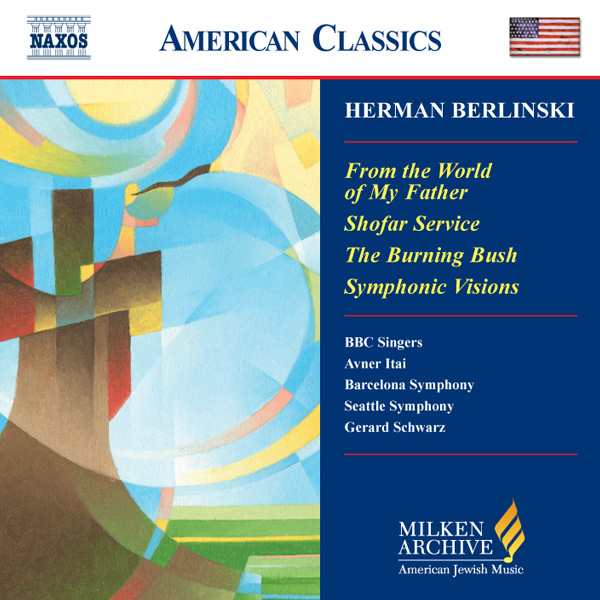Tracks
Liner Notes
In 1956 Berlinski was commissioned by Dr. Robert S. Baker, the distinguished organist at New York’s Temple Emanu-El, to write a work expressly for its Casavant organ, which was under major renovation at the time.
Baker had taught organ since 1945 (and later became dean) at the School of Sacred Music at the Union Theological Seminary in New York. He supervised the rebuilding of Temple Emanu-El’s organ, and it was he who proposed the expensive addition of two ranks of horizontal heralding trumpet stops. In the face of some resistance there, he enlisted Berlinski’s aid in convincing the congregation’s board concerning the wisdom of this addition. Berlinski himself needed no persuasion to endorse Baker’s proposal. He connected that sound in his musical imagination with the trumpetlike instruments mentioned in the Bible, and he believed the new organ stops could constitute a modern approximation. He explained to the board members that such timbres were altogether necessary to the sound of a specifically “Jewish organ”—viz., one intended for a Jewish service—and that it was not sufficient to rely for “trumpet sounds” upon the shofar-type stop that the organ already had.
In light of their success in prevailing over the board’s (and initially the rabbi’s) reservations, Baker thought it appropriate to inaugurate the rebuilt instrument with a piece that would exploit the new stops and would illustrate the new organ’s potential for power and drama. The result was Berlinski’s The Burning Bush, a rhapsodic virtuoso work that sparked the birth of his large corpus of concert organ works.
The biblical incident on which this work is based, and from which Berlinski drew his inspiration, concerns the episode in Exodus 3 wherein God appoints Moses—over his initial diffidence and fear of inadequacy—to lead the Israelites out of Egyptian bondage and to the land that will be their own as a nation. In that account, the angel, or messenger, of God appears to Moses as a voice emanating from a bush engulfed in flames, which nonetheless remains unburnt, unscorched, and intact: “the bush burned with fire, and the bush was not consumed” (v. 2). When Moses later asks in whose name he should represent himself to the people when he tells them of his appointed mission, i.e., by what name God should be identified, God replies that He should be called eh’ye asher eh’ye—“I will be what [who] I will be” (more frequently translated in English language Bibles as “I am that I am”), although the philological basis and theological construction of the words remain matters of ongoing speculation and deliberation among scholars and translators.
At the time of the commission, Berlinski was studying for his doctorate in sacred music at the Jewish Theological Seminary in New York. His first thought was to write a programmatic piece based on the biblical story of Samson, which could use the new organ’s increased potential for dramatic power to depict the scene in which Samson causes the columns to collapse merely by leaning on them. But chancing one day as he exited the seminary to observe the well-known stone image of the burning bush, together with the quotation from Exodus, on the façade of its tower above the entrance, he determined instantly to address that theme instead for his organ piece.
Berlinski could think of no melodic material or theme that would suggest the episode or those words from Exodus, but on rereading the passage in preparation for his composition, he was struck by the rhythm of the phrase eh’ye asher eh’ye, and in place of a melodic theme, he constructed a reflective rhythmic cell from those words. Together with that cell, he used a twelve-tone technique—which in part is derived from the cell—in the beginning of the piece. The row is abandoned at various points, but the rhythmic cell is always left to permeate the work in terms of variable units of differing numbers of pitches, reaching as many as the full twelve—all freely combined. That cell and its permutations thus serve two functions: a musical symbolism of the mysterious defining words for God’s name, and a structurally unifying device.
The Burning Bush had a thrilling effect when Robert Baker premiered it at Temple Emanu-El in 1956 on the instrument that Berlinski praised as “now ideally suited for the rendition of Jewish music.” Baker then played it in London at the 1957 International Congress of Organists. Its enthusiastic reception there almost immediately established Berlinski’s reputation throughout Great Britain, Europe, and America as one of the most gifted contemporary composers for the organ. In his review in The American Organist, critic Gilman Chase referred to the work as “an excellent piece...a bold contemporary effort that should be studied and played by every organist worth his salt.”
Credits
Composer: Herman BerlinskiPerformers: Barbara Harbach, Organ
Publisher: H. W. Gray, London (Theodore Presser)
Organ: The Calvary Grand Organ, 5-manual 205-rank Moüller pipe organ
